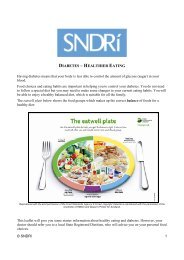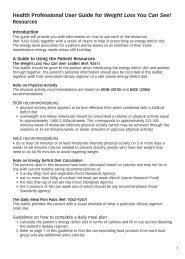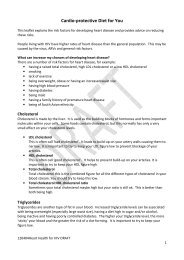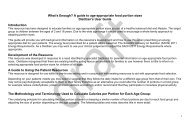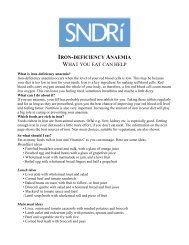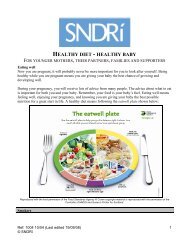9225Introduction to CHOCounting.pdf - NDR-UK
9225Introduction to CHOCounting.pdf - NDR-UK
9225Introduction to CHOCounting.pdf - NDR-UK
You also want an ePaper? Increase the reach of your titles
YUMPU automatically turns print PDFs into web optimized ePapers that Google loves.
What size is your portion?<br />
Q u i c h e<br />
Foods like pizza, pasta bake or cakes are often shared between people. For example, the label<br />
1<br />
below shows the nutritional values for 100g and for / of a quiche.<br />
Quiche<br />
FRESH AND TASTY<br />
You are going <strong>to</strong> have a 4 of the quiche. You can work out how much is in your portion by<br />
following the steps below.<br />
1 . Work out how much CHO is in the whole quiche.<br />
1<br />
Multiply the CHO in the / quiche portion by 3 <strong>to</strong> work out the CHO in the whole quiche.<br />
15.1 x 3 = 45.3g<br />
2 . Work out how much CHO is in your portion.<br />
1<br />
Divide the CHO in the whole quiche by 4 <strong>to</strong> work out the CHO in /4 .<br />
45.3 ÷ 4 = 11.3g CHO in your portion.<br />
Now try a few on your own <strong>to</strong> practice:<br />
Yo r k s h i re Pudding<br />
1 /<br />
3<br />
3<br />
1/ 3<br />
Typical values Per portion ( quiche) Per 100g<br />
Energy 251kcal 188kcal<br />
Carbohydrate 15.1g 11.3g<br />
of which sugars 3.2g 2.4g<br />
Fat 16.5g 12.4g<br />
You have eaten two Yorkshire puddings. How much carbohydra t e have you had?<br />
Remember only use the higher CHO value for the t o t a l amount of CHO.<br />
00 8





